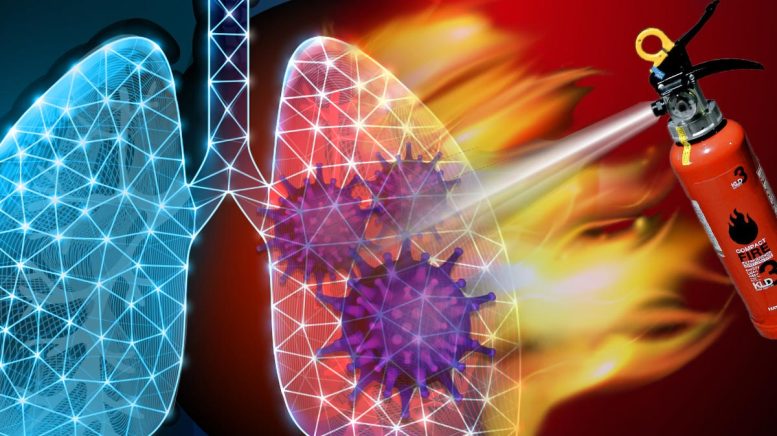
An illustration of ferroptosis in the lungs of COVID-19 patients. Credit: Nicoletta Barolini/Columbia University (“Fire extinguisher,” by Miki Yoshihito is licensed under CC BY 2.0.)
Researchers at Columbia University have discovered that ferroptosis, a specific type of cell death, is primarily responsible for the lung damage observed in severe COVID-19 cases. This finding could lead to improved treatments, as drugs that inhibit ferroptosis might enhance outcomes for patients.
In severe COVID-19 cases, the lungs can suffer extensive damage, leading to life-threatening conditions such as pneumonia, inflammation, and acute respiratory distress syndrome. Until recently, the underlying cause of these wide-ranging lung reactions had not been clearly understood.
The Role of Ferroptosis in Cell Death
Researchers at Columbia and the Columbia University Irving Medical Center have shed light on this mystery in new research published in Nature Communications. The study found that ferroptosis, a form of cell death first named and identified at Columbia in 2012, is the major cell death mechanism that underlies COVID-19 lung disease. The finding indicates that deliberately halting ferroptosis with therapeutic drug candidates could improve COVID-19 outcomes.
“This finding adds crucial insight to our understanding of how COVID-19 affects the body that will significantly improve our ability to fight life-threatening cases of the disease,” said Professor Brent Stockwell, one of the study’s lead authors.
Ferroptosis was first reported by Professor Stockwell in 2012. Ferroptosis is an unusual form of cell death in which certain cells die because their outer fat layers collapse. It differs from the most common kind of cell death, which occurs both in disease contexts and in normal processes like aging and involves cells chopping up the molecules in their interior.
Since proposing the concept of ferroptosis, Stockwell’s lab has demonstrated that it is instrumental to normal bodily processes, but that it can also attack and kill healthy cells in patients with neurodegenerative diseases like Parkinson’s, Alzheimer’s, and Lou Gehrig’s disease.
Potential Therapeutic Applications
Though ferroptosis can be destructive, recent studies indicate that it could also be harnessed for good. Intentionally inducing ferroptosis could counteract diseases like cancer where rampant cell growth is dangerously occurring. The ability to inhibit ferroptosis, on the other hand, could offer doctors new ways of combating cell death that should not be occurring, as in the case of COVID-19 lung disease.
“We’re hopeful that these important new findings could improve our ability to confront this pernicious disease, which, in too many cases, still diminishes health outcomes and results in death,” Stockwell said.
Reference: “Fatal COVID-19 pulmonary disease involves ferroptosis” by Baiyu Qiu, Fereshteh Zandkarimi, Anjali Saqi, Candace Castagna, Hui Tan, Miroslav Sekulic, Lisa Miorin, Hanina Hibshoosh, Shinya Toyokuni, Koji Uchida and Brent R. Stockwell, 20 May 2024,Nature Communications.
DOI: 10.1038/s41467-024-48055-0









Be the first to comment on "When Cells Turn Against Us: The Ferroptosis Link in COVID-19 Lung Destruction"